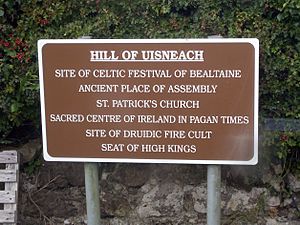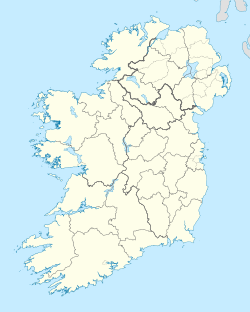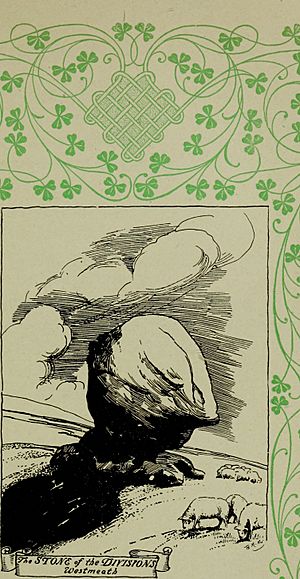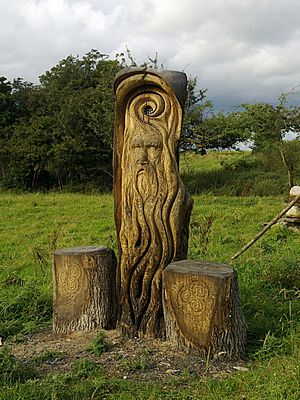Hill of Uisneach facts for kids
|
Irish: Uisneach; Cnoc Uisnigh
|
|

Information sign
|
|
| Alternative name | Ushnagh (anglicisation) |
|---|---|
| Location | County Westmeath, Ireland |
| Coordinates | 53°29′24″N 7°33′43″W / 53.490°N 7.562°W |
| Type | Ancient ceremonial site |
| Height | 182 metres (597 ft) |
| History | |
| Periods | Iron Age–Middle Ages |
| Cultures | Gaelic |
| Site notes | |
| Public access | Yes |
| Official name | Ushnagh Hill, Catstone |
| Reference no. | 155 |
The Hill of Uisneach (pronounced Ish-nakh) is an old hill and special ceremonial place in County Westmeath, Ireland. It is a protected national monument, which means it's an important historical site.
This hill has many ancient structures and earthworks. These include a possible megalithic tomb (a very old stone burial chamber), burial mounds, stone circles, standing stones, and holy wells. Some parts of the site date back to prehistoric times, and others are from the Middle Ages.
Uisneach is close to the middle of Ireland. In Irish mythology, it is seen as the most important and sacred spot on the island. People believed it was where the mythical Tuatha Dé Danann (an ancient race of gods and heroes) were buried. It was also a meeting place for druids (ancient Celtic priests) and for the festival of Bealtaine.
The top of the hill is 182 meters (597 feet) above sea level. It is located near the village of Loughanavally. The hill spreads across four different areas called townlands: Ushnagh Hill, Mweelra, Rathnew, and Kellybrook. Long ago, Uisneach was connected to the Hill of Tara by an ancient road called the Slighe Assail.
Contents
What's in a Name?
The hill is called Uisneach in both Irish and English. Another Irish name for it is Cnoc Uisnigh, which simply means "hill of Uisneach". Sometimes, you might see it spelled 'Ushnagh', especially for the local area.
Experts think the name Uisneach might come from old words meaning "place of the hearth" or "place of cinders". This suggests it was a place where sacred fires were lit. Another idea is that it means "angular place".
Exploring the Features
The Hill of Uisneach is a large site, covering about two square kilometers. You can see about twenty ancient monuments and earthworks. Scientists have also found signs of at least twenty more hidden underground. These sites show that people have been active here for about 5,000 years, from the Neolithic period (New Stone Age) to the early Middle Ages.
Archaeologists like R.A.S. Macalister and R. Praeger dug up parts of the site in the 1920s. Their work helped us learn more about its history.
Views from the Top
From the top of Uisneach, you can see amazing views. On a clear day, you can spot hills in at least twenty different counties!
At the very top of the hill, there are the remains of a possible megalithic tomb. This tomb is known as 'St Patrick's Bed'. It used to be surrounded by a circular ditch.
Loch Lugh and Carn Lughdach
Down the hill to the east, there's a small lake called Loch Lugh or Loch Lugborta. East of this lake, on a small rise, is a burial mound called Carn Lughdach. This mound also used to have a ditch around it.
Holy Wells
South of these features are two holy wells. One of them is called Tobernaslath. It sits next to a circular enclosure and a standing stone.
The Cat Stone
On the southwest side of the hill, you'll find a very large, unusual limestone rock. It's almost 6 meters (20 feet) tall and weighs more than 30 tons! This rock was left here by a glacier a long, long time ago.
In ancient times, people dug an earthen bank around this rock to show it was a special place. In Irish, it's called the Ail na Míreann, which means "stone of the divisions". People believed it was the spot where the borders of the ancient provinces of Ireland met. It's also nicknamed the Cat Stone because some people think it looks like a sitting cat.
Rathnew: A Place of Fire and Kings
The biggest monument at Uisneach is Rathnew. It's the remains of an earthwork shaped like a figure-of-eight. An old road from the bottom of the hill leads towards Rathnew.
Rathnew was first a single round enclosure with a ditch and an entrance on the east. Inside, archaeologists found pits with partly-burnt animal bones. These pits were covered with large flat stones. It seems that fires were lit here and then quickly put out with water or soil, as part of a special ritual. There was also a large bed of ash with completely burned animal skeletons. This suggests it was a sacred place where fires were kept burning, or lit often, and where animals were offered as sacrifices.
Later, in the early medieval period, a larger figure-of-eight shaped earthwork was built here. It had a big round enclosure connected to a smaller one, both marked by banks and ditches. Inside each enclosure were small stone buildings and underground passages called souterrains.
It's thought that Rathnew was a place for royal and religious gatherings. It might even have been a royal home for the kings of Meath during these meetings. The chieftains of Clann Cholmáin, who became kings of Meath, were even called "Kings of Uisnech" in old king lists.
Uisneach in Irish Mythology
In Irish mythology, Uisneach is described as the sacred heart of Ireland. It was believed to be the burial place of Irish gods like Lugh and the Dagda. It was also home to a sacred tree called the Bile Uisnig.
Uisneach was a major meeting place (the mórdáil Uisnig) for druids. According to old stories, these meetings happened during the festival of Bealtaine. The Ail na Míreann (the Cat Stone) is especially important in myths. It's called the "navel" or belly button of Ireland. It was seen as a special spot where the Earth and the Otherworld connected, and where creation began. It was also said to mark where the ancient provinces of Ireland met.
Tales of Uisneach
The Dindsenchas (which means "lore of places") tells a story that the druid Mide lit a sacred fire on Uisneach. This fire supposedly burned for seven years!
Another tale, Tucait Baile Mongáin, says that a huge hailstorm during a meeting on the hill created the twelve main rivers of Ireland.
In the Lebor Gabála Érenn ("Book of the Taking of Ireland"), the Gaels (also called Milesians) meet the goddess Ériu at Uisneach. After some talking, the Milesian poet Amergin promises to name the land after her. Ériu herself is said to be buried under the Ail na Míreann.
Uisneach and Tara
In mythology, Uisneach and the Hill of Tara are often linked. Tara is mostly connected with royal power and kings. Uisneach, on the other hand, is mainly associated with spiritual power and ancient rituals.
Both places had important festivals or meetings every seven years. The Feast of Tara happened at Samhain (Halloween), where new laws were made. The Great Meeting of Uisneach took place at Bealtaine (May Day). The Fair of Tailtiu, held at Lughnasadh (August 1st), was also very important to the ancient Irish.
Deirdre of the Sorrows
Uisneach is also mentioned in the sad tale of "Deirdre of the Sorrows". Deirdre was born with a prophecy that her beauty would cause wars. Conchobar mac Nessa, the King of Ulster, kept her hidden away to marry her later. But Deirdre fell in love with Naoise, a handsome young warrior. They ran away to Scotland with Naoise's loyal brothers, Ardan and Ainnle, who were known as the Sons of Uisneach.
Stonehenge Connection
An old book called Historia Regum Britanniae ("History of the Kings of Britain") by Geoffrey of Monmouth says that Stonehenge (the famous stone circle in England) originally stood at the 'hill of Killare' in Ireland. Many believe this refers to Uisneach, because Killare is a place right at the foot of the hill.




